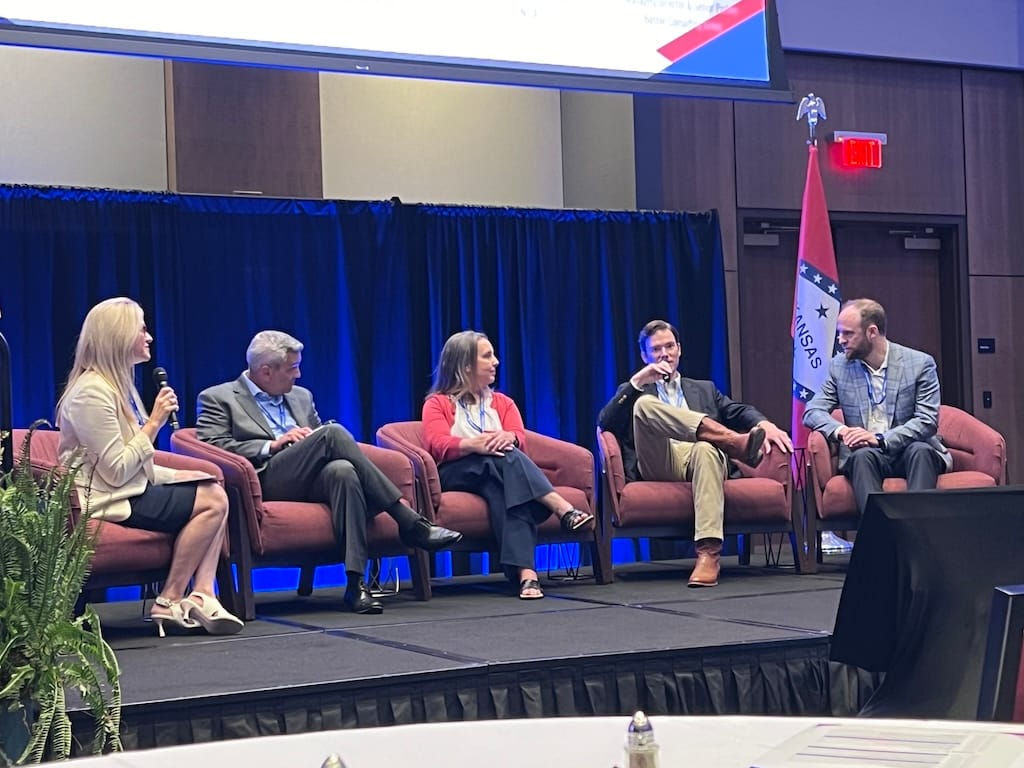
Arkansas
The office has found a ‘Goldilocks’ solution for project areas and reimbursements, its deputy director said Tuesday.

 From left: Abby H. Holsclaw, president and CEO of Proper Southern Strategies; Lane Bailey, deputy director of the ASBO; Laurie Ringler, director of government affairs at Cablelynx; Philip Powell, federal program officer at the NTIA; and Land McBride, senior partner at Boston Consulting Group. Photo by Drew Clark
From left: Abby H. Holsclaw, president and CEO of Proper Southern Strategies; Lane Bailey, deputy director of the ASBO; Laurie Ringler, director of government affairs at Cablelynx; Philip Powell, federal program officer at the NTIA; and Land McBride, senior partner at Boston Consulting Group. Photo by Drew Clark
HOT SPRINGS, Ark., June 25, 2024 – The Arkansas State Broadband Office is bringing lessons learned from past grant programs to the state’s latest federal funding allocation, state Deputy Director Lane Bailey said here Tuesday.
Arkansas was handed more than $1.02 billion as part of the Broadband Equity, Access and Deployment program, the $42.5-billion broadband expansion effort stood up by the Infrastructure Act in 2021. The state is set to finalize its broadband coverage map on Friday, after which it will send the list of eligible locations to the federal agency managing the program.
The state previously administered grants through multiple rounds of the Arkansas Rural Connect program, both with state money and the federal American Rescue Plan Act funding from the U.S. Treasury Department. The last round of $53 million in ARPA funding was awarded through the the state’s broadband office in October 2022.
“In the first couple of rounds, we distributed all the funds up front,” Bailey said. “‘All right, here are your funds, go build a network. We’ll look at what you did in a couple of years.’ You can see how that would be problematic.”
Bailey spoke at the Arkansas BEAD Digital Opportunity Conference here.
The upfront distribution was influenced by a desire to both stimulate the local economy and get infrastructure up and running quickly amid the COVID pandemic, Bailey said.
“It needed to be done, but people got burned. Our office got burned, and some communities who were expecting to get broadband got burned,” he said. “It didn’t happen a lot, just a couple of cases, but you can see how providing all the funds up front could be problematic.”
In later rounds, the office switched to a reimbursement model in which ISPs submitted receipts that the state would pay back after verifying the expense was eligible under ARC rules.
“If anybody suggests that might be an overcorrection, I would probably agree with you,” Bailey said.
The state has a new approach with incoming BEAD money.
“So with BEAD what we’re going to do– what we hope is maybe a Goldilocks solution – is we’re going to move to a milestone-based distribution of funds,” he said. “You complete a certain milestone in the construction, we verify it, and we will distribute the funds. We think it’ll be smoother.”
Experience based on project area size
Another area in which Arkansas’s BEAD plan was informed by past experience was its project areas. States are afforded flexibility in how they define the program’s project areas, the geographic areas for which ISPs will apply to serve with high-speed internet with grant funding.
“Early on [in the ARC program], project areas were selected by ISPs,” Bailey said. “Obviously, you’re going to pick the easiest ones, to get an easy return on investment. That’s great, but it didn’t reach all the Arkansans it needed to reach.”
For the last round of funding, the state chose project areas in an effort to get the hardest to reach locations served.
“These project areas didn’t match any ISP’s strategic plan, which made it very difficult,” Bailey said.
For BEAD, the state is planning to allow applicants to construct their own project areas out of census block groups – geographic areas with anywhere between 600 to 3,000 people. Under its current draft plan, applicants can not seek grant funding to serve only part of any given census block group, ideally resulting in less competitive areas in the same block group as more attractive ones still being served through the program.
“You can have a project area as small as one Census block group, but you can then connect block groups as building blocks to create your own project areas that align with your networks and your strategic planning,” he said. “Again, we think we’ve hit a Goldilocks version for project areas and for reimbursement.”
The second volume of Arkansas’s BEAD plan, which outlines the above procedures, has yet to be approved by the NTIA. Once that approval comes down, the state will have one year to award subgrants under the program. Top NTIA officials have testified to Congress that the agency was looking to get all volume two submissions approved by this fall.
